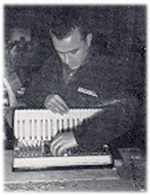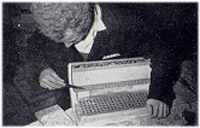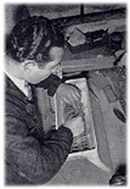Few people realize the intricate and detailed steps required to produce an accordion. About 6000 parts are combined in a process involving hundreds of man hours to bring an accordion to life. The better factories embark on the construction years before the instrument is actually fabricated. Fine, precut woods are patiently stored a minimum of three years, under rigid temperature, humidity and air current control, to assure the full seasoning cycle before they will be used to build a future instrument. An average of 300 square inches of prime suede and kidskin will be used for each accordion. These leathers must be dated and ideally stored for additional aging of at least two years before careful selection is made for use. Celluloids, specially formulated for accordion fabrication, are ideally of extra heavy grade with deep color pigmentation to permit the multiple sanding and buffing required to obtain the rich gloss finish. Celluloid, too, must have years of aging under ideal conditions to eliminate the material's tendency towards shrinkage. The reeds of a quality accordion must be vibrant Swedish blue steel, hand-fitted, riveted on precision duraluminum plates, and individually tuned for brilliant voicings. It is a formidable realization to conceive that the usual accordion with four sets of treble reeds and five sets of bass reeds has no less that 448 single reed tongues to be painstakingly tuned by a craftsman who specializes in the time honored skill. In these pictures and captions, Accord conducts you on a guided tour through an accordion factory in Italy. Not all phases of accordion production are pictured, but enough are shown to give the reader an idea of how an accordion makes its way into the world of music. 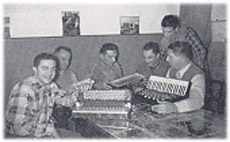 Engineering and design problems take endless hours as the instrument's evolution
results in advancements. Here, in an informal European atmosphere, countless
years of experience in accordion construction are pooled to arrive at solutions
which will enhance the accordion's position in the music world.
Engineering and design problems take endless hours as the instrument's evolution
results in advancements. Here, in an informal European atmosphere, countless
years of experience in accordion construction are pooled to arrive at solutions
which will enhance the accordion's position in the music world.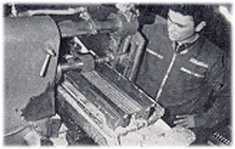 These are various stages in the assembly of the accordions' treble keyboards
- similar in either piano key or button style. The treble plates must be
carefully channeled for trouble free operation. Great skill is required
to assemble a first-class keyboard mechanism and even more care must be
taken if the treble includes tone chamber construction.
These are various stages in the assembly of the accordions' treble keyboards
- similar in either piano key or button style. The treble plates must be
carefully channeled for trouble free operation. Great skill is required
to assemble a first-class keyboard mechanism and even more care must be
taken if the treble includes tone chamber construction.
Skilful craftsmanship and carefully chosen materials are vital components of a fine quality accordion. No short cuts are possible when producing instruments which are truly responsive and capable of the most magnificent musical range and colorations. 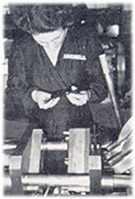 Injection molding produces the black keys for sharps and flats. Precision
dies are used to make a variety of functional and ornamental components
of the accordion.
Injection molding produces the black keys for sharps and flats. Precision
dies are used to make a variety of functional and ornamental components
of the accordion.Great effort is required to 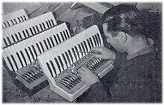 make
the treble registers respond instantly by activation the slides which open
and close appropriate tone holes, permitting the desired reed combinations
to sound. Here, the molded levers are fitted to the treble switch assembly
on the grille and the inner mechanism of the treble registers is adjusted
for smooth operation. make
the treble registers respond instantly by activation the slides which open
and close appropriate tone holes, permitting the desired reed combinations
to sound. Here, the molded levers are fitted to the treble switch assembly
on the grille and the inner mechanism of the treble registers is adjusted
for smooth operation.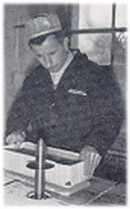 The The
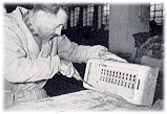 Many
stages of bass case construction require much careful work, such as this
painstaking shaping on a circular spindle cutting machine, the final woodwork
detailing, and trimming the smoothly-contoured plastic covering. Many
stages of bass case construction require much careful work, such as this
painstaking shaping on a circular spindle cutting machine, the final woodwork
detailing, and trimming the smoothly-contoured plastic covering.Few musicians can rise above the limits imposed by their instrument. A fine accordion will unleash creativity through its increased musical capacity and potentially expanded musical scope. 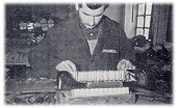 The sea of bass buttons, which confounds the novice, is no mystery to these
craftsmen who carefully assemble the intricate bass machine mechanism. Rods
and pistons, brass pins and mechanical-noise insulators are individually
positioned to create the wonderous bass machine, some of which provide innovations
such as convertor or chromatic free bass and pedal tones in addition to
the stradella system.
The sea of bass buttons, which confounds the novice, is no mystery to these
craftsmen who carefully assemble the intricate bass machine mechanism. Rods
and pistons, brass pins and mechanical-noise insulators are individually
positioned to create the wonderous bass machine, some of which provide innovations
such as convertor or chromatic free bass and pedal tones in addition to
the stradella system.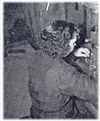 The various reed operations are numerous, beginning with a huge power
The various reed operations are numerous, beginning with a huge power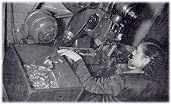 press which die-stamps the plates, the making of the multi-chambered reed
blocks, the precise die-cutting of the reed tongues, selection provino-tuned
reeds and carefully waxing them onto the blocks to assure air-tight fit.
press which die-stamps the plates, the making of the multi-chambered reed
blocks, the precise die-cutting of the reed tongues, selection provino-tuned
reeds and carefully waxing them onto the blocks to assure air-tight fit.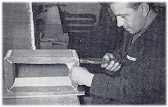 The bellows, which enable the instrument to offer an amazing range of expression,
are constructed of special cardboards, lined with fabric and leather "diamonds"
which are positioned in the corners of each fold. All outer sides have folds
tape-reinforced, bonded with specially formulated hot glue and finished
with precision pinched chrome corners. Here, electroplating the bellows'
corners in a chrome bath and pinching them into positions shown.
The bellows, which enable the instrument to offer an amazing range of expression,
are constructed of special cardboards, lined with fabric and leather "diamonds"
which are positioned in the corners of each fold. All outer sides have folds
tape-reinforced, bonded with specially formulated hot glue and finished
with precision pinched chrome corners. Here, electroplating the bellows'
corners in a chrome bath and pinching them into positions shown.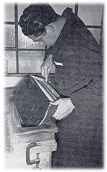 After the treble and bass selections have been assembled, the reeds in each
are tuned by a craftsman. Following this, the instrument will be fully assembled
and both sides will be tuned to each other to complete the process.
After the treble and bass selections have been assembled, the reeds in each
are tuned by a craftsman. Following this, the instrument will be fully assembled
and both sides will be tuned to each other to complete the process.When purchasing an accordion there are many points to consider. The instrument represents a sizeable investment which warrants careful study. Some important considerations are enumerated below. Most of them are equally significant whether the accordion is brand-new or an older, second-hand instrument. Keyboard and ActionFast action is important; released keys must close firmly, their pads must cover without leakage and be fastened securely. Avoid keys which bind, stick, or are warped - keyboard must be level, not too high, have uniform action, and no mechanical noise.Basses and ActionBasses must be responsive; buttons should come up quickly and firmly. Chord buttons must produce complete, accurate chords. Mechanical noise must be eliminated.Reeds and Reed Blocks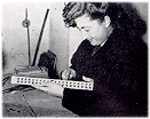 The
accordion must be able to play a sustained note very loud or very soft and
respond instantly to the slightest bellows movement. Response of all reeds
should be balanced on a chord. Blocks must be seated perfectly to avoid
air loss or waste, They should have multiple coats of high-lustre varnish
to enhance tone and protect against warpage. The
accordion must be able to play a sustained note very loud or very soft and
respond instantly to the slightest bellows movement. Response of all reeds
should be balanced on a chord. Blocks must be seated perfectly to avoid
air loss or waste, They should have multiple coats of high-lustre varnish
to enhance tone and protect against warpage.TuningCheck for accuracy to be sure the accordion is in tune with other instruments as well as itself - both hands and in all reed lines.Bellows, Gaskets and PadsIf these are poorly attached, badly made or mal-fitting, the instrument will "leak" and require extra hard pumping instead of the normal easy pressure required to play a sustained note.Registers and PlatesWhen plates are warped or badly fitted, registers cannot work smoothly and air loss may result. Examine for excess "play" and be sure registers and slides close ports fully.Instrument ServiceLegitimate dealers provide service facilities. The best source for student instruments is a dealer who offers a planned program of music education with good lessons, expert service and future aids. Maximum advantages are available from a reputable dealer who is able and willing to serve customers' musical needs.Factory Name BrandsAvoid "fake" brand names. Trace the name to be sure that a real manufacturer and a known factory of good reputation actually stand behind the instrument. Brands which are the name of the importer usually are not produced in a reputable factory and therefore cannot offer consistent quality. |
